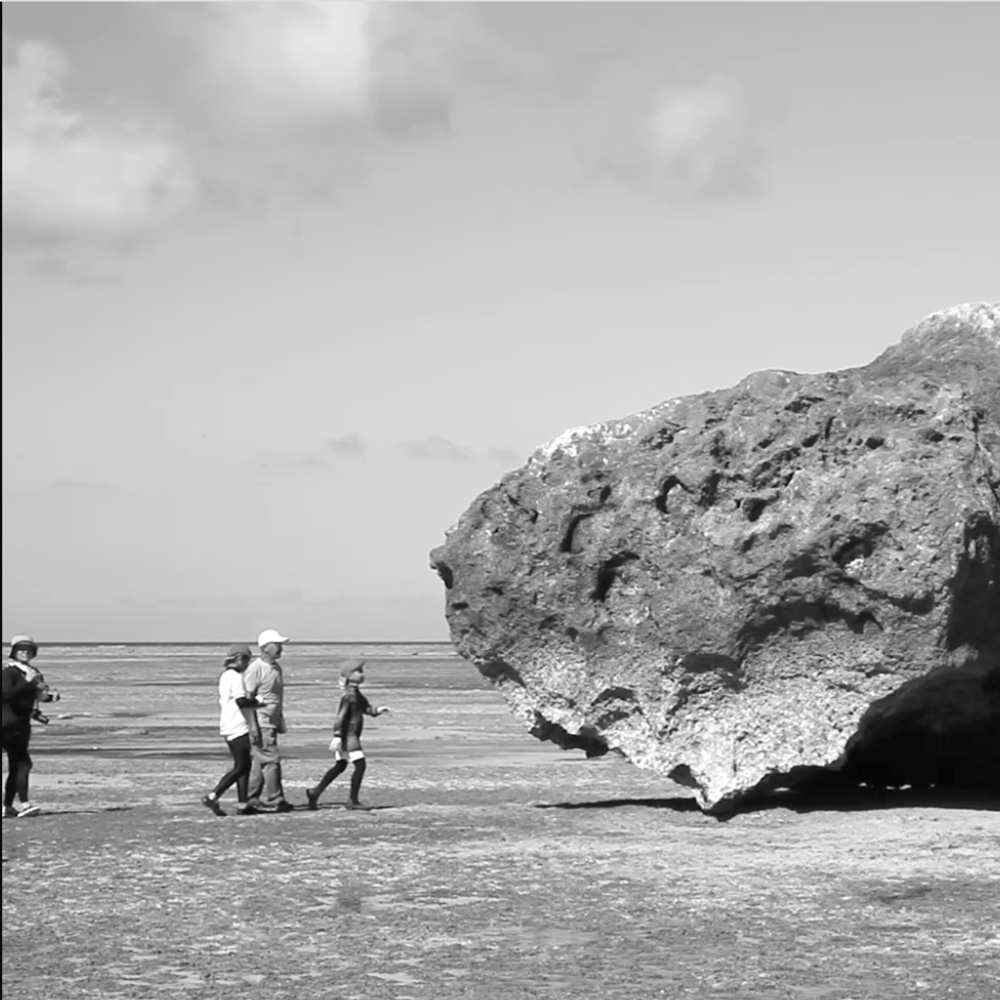-Followed by English translation-
地球科学を専門とする私は日頃、露頭(岩盤が露出した崖)以外に関心を払うことはない。なぜなら露頭はその地域や日本列島の成り立ち、ひいては地球の歴史といった情報を持っているからだ。下道氏との出会いはそんな私に物事を多面的に考察する習慣をもたらした。
人々の生活とは直接関係のない露頭に視線を向ける私に対して彼は人と共にある石に対して視線を向ける。同じように岩石を相手にしてはいるが、その点において私と彼は対極的と言える。その一方、私も彼も屋内に籠るのではなく、フィールドで活動するタイプだという点については全く同じでもある。
今回の黒部市美術館からの依頼は、当初、単に生活圏にある岩石・鉱物についての座学的な内容を教えて欲しいというものだった。私はすぐに「せっかくだから私が富山県東部をご案内しましょう。」と申し出た。その理由はいくつかあるが、分野の違う二人が同じフィールドに出てどのように感性が異なっているのかを直接確かめたかったからだ。
私は彼の過去の作品群から推察して、彼の関心を惹き付けそうな場所を案内した。それらは祀られている自然石、石仏に供え物として置かれた白い石、おびただしい量の石が積まれた一里塚といった信仰対象や史跡であり、人が明確な意図を持って石を使用している例が中心だった。ところが、彼がより高い関心を示したのは、案内の途中で見かけた漬物石として使われている川から引き上げられた石、石材屋が廃材を利用して作った石垣や、庭先で無造作に積まれた人頭大の石などだった。これらは当初から明確に用途が決められていたのではなく、人が何気なく、ともすると何かの代用として、「日常で使うことにした石」だ。このようにして狙い通り一緒にフィールドに出ることによって、互いの感性の違いを浮き彫りにすることができた。
次に、おぼろげながらに見えた彼の感性から、芸術に疎い私なりに彼が示そうとしている概念はどのようなものか考えてみた。石は河原や海岸で転がっている時は人の生活に役立っている状態ではない。しかし、そこで人が石を何かに使おうと「思いつく→拾う」という動作をした瞬間、石に果たすべき役割が与えられ、次に実際に使用する瞬間に道具に変化するということを示そうとしているのではないかと思う。
このような彼の示そうとする概念を意識しながら日常生活を送ると、我々は一つのモノが持つ様々な特徴を捉え、その都度全く別の用途に使用しいていることに気がつく。例えば、私はカップラーメンに湯を入れて3分待つ間、ほぼ毎回割り箸を蓋の上に置いていることに気がついた。この時私は割り箸の質量という側面に着目し、蓋を押さえる重石として使用していることになる。
このようなことは、地殻でも起こっている。例えば断層について考えてみる。断層は地殻にかかる応力の解放によって生じた亀裂であり、活断層ならば物理的条件が揃い次第、地殻に蓄積した応力をくり返し解放する機能を果たしている。一方で断層は弱面でもあるので、水やガス、時にはマグマなどの物質の移動経路としても機能している。
私の専門は地質時代において二枚貝の仲間がどのように関係し合って生活していたのかを化石を用いて明らかにする研究を行っているのだが、今回彼の示す概念と出会い、今までよりも生物が生物群集の中でどのような相互関係を持ち、どのように機能していたのかを多面的に捉える習慣ができ始めた。
彼はこの先どのような概念を提示してくれるのだろうか。まだ見ぬ彼の作品に思いを馳せつつ筆を置く。
久保貴志(黒部市吉田科学館学芸員)
:::::::::::::::::::::::::::::::
Open yourself to the functions concealed in objects
Takashi Kubo
As a specialist of the Earth Sciences, I usually do not give much thought to anything other than rocky outcrops. Outcrops hold the key to the origins not only of a particular area, and the archipelago of Japan, but also to the history of the Earth. The opportunity to meet Mr. Shitamichi has led me to consider the world around me in a more multifaceted manner.
In contrast to myself, who views the outcrop as something with no direct relationship to people’s lives, Motoyuki Shitamichi turns his gaze to the stones that exist alongside people. Though we both study rocks and stones, we differ greatly on this point. On the other hand, neither of us enjoy being confined to the indoors, preferring to be out in the field.
The original request I received from the Kurobe City Art Museum, was that they required theoretical content regarding the rocks and minerals solely in our sphere of living. I immediately offered to be a guide for the eastern area of Toyama. I had several reasons for doing this, but primarily, I wished to confirm directly how two people from different specialties approach the same field, and how their appreciation of this field differs.
Making assumptions based on his past works, I decided to show Mr. Shitamichi around a certain area that I believed would capture his interest. There were many examples of stones which were used with a clear intent by humans: natural stones that were objects of worship; white stones placed as offerings before stone images of Buddha; abundant stones piled up as objects of religious milestones and historical landmarks. However, he was most interested in the stones we saw that had been carried from the river to be used when making pickles, the stone walls that had been built using unwanted materials from the stonemason, and the stones the size of a person’s head casually piled up in a garden. Those stones did not originally have a clear purpose, but were stones that people had inadvertently used in place of something else, stones which were given a role in daily life. Just as I believed would happen, the differences in our sensibilities were thrown into sharp relief by going out into the field together.
Then, through my vague understanding of his sensibilities, and my ignorance of the arts, I attempted to understand the concepts he was trying to capture. When a stone is lying in the riverbed or on the seashore, it is not in a state of being useful in people’s lives. However, if someone thinks to use a stone for something, in the instant when that idea leads to the stone being picked up; the stone is given a function to serve. When the stone is then used to serve this function it becomes a tool. I believe it this concept that he is trying to present.
While bearing this concept in mind, we can see that while we are able to grasp the various characteristics of a particular object, we also use that object for something completely different at other times. For example, I realized that when I pour hot water into my cup of instant noodles, and am waiting for the required three minutes, I nearly always place my disposable chopsticks on top of the lid. When doing this, my attention is focused on the mass of the chopsticks, and I am using them as a weight to hold down the lid.
The same thing is occurring in the earth’s crust. Consider a fault line. A fault is a fissure that is caused when stress placed on the earth’s crust is released. In the case of an active fault, the function to repeatedly release the accumulated stress occurs when all the required physical conditions are present. On the other hand, because the fault is a weak surface, it also functions as a path for the movement of water, gas, and at times magma.
My area of expertise is in the Geological Age. Through research using fossils, I try to throw light on how bivalve families were related to each other, and how they lived. Through meeting Motoyuki Shitamichi, and the concept he is presenting, I have started to develop the habit of multilateral thinking in terms of how living organisms functioned, and how they were interrelated within the biological community.
I am curious to see what concepts Mr. Shitamichi will present us with in the future. It is with thoughts of his unseen work, that I stop writing.
Curator
Kurobe Yoshida Science Museum
